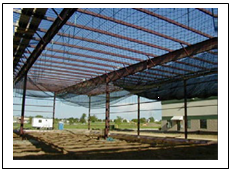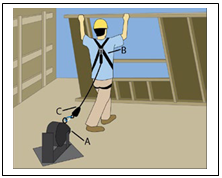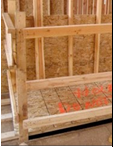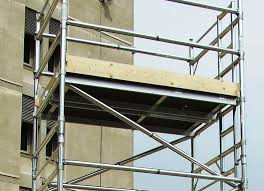| 1. |
What portion or percentage of fatalities in construction are caused by falls? |
|
|
10% |
|
|
20% |
|
|
1/3 of all accidents |
|
|
50% |
| 2. |
What is Subpart M? |
|
|
Subpart M deals with Machinery and equipment in the field. |
|
|
Subpart M lays out the requirements and criteria for fall protection in construction workplaces. For example, it applies when workers are working at heights of 6 feet or mre above a lower level. It also covers protection from falling objects, falls from tripping over or falling through holes, and protection when walking and working around dangerous equipment without regard to height. |
| 3. |
When must employers provide fall protection? |
|
|
When the working area seems high and there might be a possibility of someone getting injured if he falls. |
|
|
When the workers are working at a height of 6 ft. or higher. |
| 4. |
Guardrail systems are barriers erected to prevent workers from falling to lower levels. Guardrail systems must be capable of withstanding a force at least __________ applied within 2 inches of the top edge, in any outward or downward direction, at any point along the top edge. 29 CFR 1926.502

|
|
|
200 pounds |
|
|
250 pounds |
|
|
300 pounds |
| 5. |
A steep roof has a slope greater than 4 in 12 (vertical to horizontal). When working on a steep roof that has one or more unprotected side or edge 6 feet or more above lower levels, each worker must be protected by: Guardrail systems with toe boards, Safety net systems , or Personal fall arrest systems. |
|
|
True |
|
|
False |
| 6. |
When safety nets are used, they must be installed as close as practicable under the walking or working surface on which workers are working and never more than ______ below that level. 29 CFR 1926.502(c)(1). When nets are used on bridges, the potential fall area from the walking or working surface to the net must be unobstructed. 29 CFR 1926.502(c)(1). All safety nets must be installed with sufficient clearance underneath to prevent a falling body from hitting the surface or structure below the net. 29 CFR 1926.502(c)(3).

|
|
|
30 feet |
|
|
20 feet |
|
|
10 feet |
| 7. |
A personal fall arrest system is a system used to safely stop (arrest) a worker who is falling from a working level. Which of the following does arrest system consists of?

|
|
|
An anchorage |
|
|
connectors |
|
|
A body harnesses |
|
|
It also may include a lanyard, deceleration device, lifeline, or suitable combinations of these. Under Subpart M, body belts (safety belts) are prohibited for use as part of a personal fall arrest system. |
|
|
All of the above |
| 8. |
Each worker on a walking or working surface must be protected from tripping in or stepping into or through holes (including skylights) by covers. 29 CFR 1926.501(b)(4)(ii). As a safety _________ to put a guard rail surrounding it.

|
|
|
It is a good idea |
|
|
It is not a good idea |
| 9. |
Do you need a personal fall arrest when working less than 6 feet above dangerous equipment? |
|
|
You do not need a personal fall arrest |
|
|
You do need a personal fall arrest |
| 10. |
Toeboards must be capable of withstanding, without failure, a force of at least 50 pounds applied in any downward or outward direction at any point along the toeboard. 29 CFR 1926.502(j)(2).
- Toeboards must be at least 3.5 inches tall from their top edge to the level of the walking or working surface, must have no more than 0.25 inch clearance above the walking or working surface, and must be solid or have openings no larger than one inch in its greatest dimension. 29 CFR 1926.502(j)(3).
- Where tools, equipment, or materials are piled higher than the top edge of a toeboard, paneling or screening must be erected from the walking or working surface or toeboard to the top of a guardrail system’s top rail or midrail, for a distance sufficient to protect workers below. 29 CFR 1926.502(j)(4).

|
|
|
True |
|
|
False |
| 11. |
CPSC (Consumer Product Safety Commission) warns that consumers can be electrocuted when they use ladders near overhead wires. Consumers may use ladders near overhead wires to clean gutters, paint structures, trim trees, and repair roofs and chimneys. Many over head power lines are not insulated. |
|
|
True |
|
|
False |
| 12. |
CPSC (Consumer Product Safety Commission) advises to use a fiber glass ladder to avoid electrocutions. It also warns when workers or consumers move ladders if it touches electrical wire near the house: |
|
|
They can get electrocuted |
|
|
They cannot get electrocuted |
| 13. |
When using a ladder which of the following are important?
- Be sure straight ladders are long enough so that the side rails extend above the top support point, by at least 36 inches.
- Don’t set up ladders in areas such as doorways or walkways where others may run into them, unless they are protected by barriers. Keep the area around the top and base of the ladder clear. Don’t run hoses, extension cords, or ropes on a ladder and create an obstruction.
- Don’t try to increase the height of a ladder by standing it on boxes, barrels or other materials. Don’t try to splice two ladders together.
- Do not apply personal or job stickers/decals.
- Set the ladder on solid footing against a solid support. Don’t try to use a stepladder as a straight ladder.
- Place the base of straight ladders out away from the wall or edge of the upper level about 1 foot for every 4 feet of vertical height. Don’t use ladders as a platform, runway or scaffold.
- Tie in, block or otherwise secure the top of straight ladders to prevent them from shifting.
- To avoid slipping on a ladder, check your shoes for oil, grease or mud and wipe it off before climbing.
- Always face the ladder and hold on with both hands when climbing up or down. Don’t try to carry tools or materials with you.
- Don’t lean out to the side when you’re on a ladder. If something is out of reach, get down and move the ladder over.
- Most ladders are designed to hold only one person at a time. Use by two workers may cause the ladder to fail or throw the ladder off balance.
|
|
|
1, 3, 4 and 8 |
|
|
1, 2,3, 6, 10 |
|
|
All of the above |
| 14. |
Which of the following are important when designing scaffolding?
- All scaffolds must be fully planked and constructed to support the load they are designed to carry. Scaffold planks must be cleated or secured, or extend over the end supports by at least 6 inches, but not by more than 12 inches.
- Ties, guys, and braces for a scaffold must be installed according to the scaffold manufacturer’s recommendations. If the specifications are unknown then the standards at 29 CFR 1926.451(c)(1) must be followed.
- Barrels, boxes, kegs, horses, ladders, loose tile blocks, loose piles of bricks, A-frames or other unstable objects shall not be used as work platforms or to support scaffolds. Never use work platforms mounted on top of other work platforms.
- Guardrails, midrails and toeboards must be installed on all open sides of scaffolds, 10 feet or more in height.
- Falling object protection must be provided in areas where persons are required to work or pass under a scaffold.
- Overhead protection is required if employees working on scaffolds are exposed to overhead hazards.
|
|
|
1,2,4,5 |
|
|
1,3,5,6 |
|
|
All of the above |
| 15. |
In using scaffolding, which of the following are important?
- Inspect scaffolds daily before you trust your life to them. Check guardrails, connectors, fastenings, footings, tie-ins, bracing and planking. Damaged scaffolds must be removed from service immediately.
- Do not climb cross-bracing as a means of access.
- Don’t stockpile materials on scaffolds. Remove all tools and leftover materials at the end of the day.
- Never overload scaffolds. Pile necessary materials over ledger and bearer points.
- Keep platforms and area near the scaffold clear of debris, unneeded equipment or material, and anything else that might cause you to slip or trip.\
- Use access ladders provided for each scaffold. Climbing off the end frames is prohibited.
- In winter, clear platforms of all ice and snow before using. Sand wet planking for sure footing.
- Never ‘ride’ a (mobile) rolling scaffold.
- Only use a rolling scaffold on level surfaces, and lock caster breaks when not in motion. When moving, make certain the route is clear of holes and overhead obstructions. Secure all loose materials.
- Use personal fall protection equipment tied off to an anchorage point from a lanyard, lifeline and/or deceleration device, when working from floats, needle beam scaffolds, or suspended scaffolds.
- Protect ropes and safety lines from burning or welding.
|
|
|
1,2,3,4 and 8 |
|
|
1,2,3,4,6,9, and 11 |
|
|
All of the above |
| 16. |
Which of the following would be considered fall hazards?
- Unprotected leading edge work
- Unprotected wall and floor openings
- Hoist areas
- Uncovered holes
- Roof and elevator openings
- Poor working surface integrity
- Unprotected ramps and runways
- Dangerous equipment
- Form work and reinforcing steel
- Excavations, wells and pits
|
|
|
1,2,3,4 |
|
|
1,2,3,4,10 |
|
|
All of the above |
| 17. |
What steps do we take to keep us working safely on roofs?
- Use PFASs or other fall protection systems, as per the OSHA Fall Protection standard.
- Train workers in hazard recognition and the OSHA Fall Protection standard to properly identify and understand the severity of fall hazards and certify through a written record.
- Guard or secure covers over holes with materials of sufficient strength, and write “Hole” over the cover upon observing the fall hazard.
- Provide and use safety monitor systems, warning line systems, or controlled access zones, in accord with the OSHA Fall Protection standard.
|
|
|
1,2,4 |
|
|
1,2,5 |
|
|
All of the above |
| 18. |
One place where one could see preventive Videos would be www.osha.gov/stopfalls |
|
|
True |
|
|
False |
| 19. |
Fall Prevention Fact Sheet is available in |
|
|
English only |
|
|
Spanish |
|
|
English and Spanish |
| 20. |
Could the simple 3 lines below be used in preventing falls.
Plan ahead to get the job done safely.
Provide the right equipment.
Train everyone to use the equipment safely. |
|
|
Yes |
|
|
No |
|